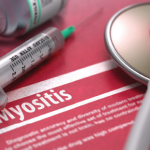In recent years, scientists and clinicians have learned a great deal about autoantibodies occurring in idiopathic inflammatory myopathies (IIMs). These new discoveries have reshaped our understanding of distinct clinical phenotypes in IIMs. Scientists continue to learn more about how these autoantibodies shape pathophysiology, diagnosis, disease monitoring, prognosis and optimum treatment. Moving forward, these autoantibodies will likely come to play an even greater role in the assessment and treatment of these conditions.
Background
The idiopathic inflammatory myopathies are a complex, heterogeneous group of autoimmune diseases. These conditions affect primarily the muscles, but they sometimes affect multiple body systems. Because of this, IIMs often require coordinated care from rheumatologists, neurologists, respiratory physicians, dermatologists and other specialists.1-5
Historically, clinicians divided these patients into one of two groups: polymyositis (PM) or dermatomyositis (DM). Later classification schemes included the subcategories of immune-mediated necrotizing myopathy, sporadic body inclusion myositis, cancer-associated myositis and juvenile disease. The classification is even more complicated, because some cases of IIM share overlapping features with certain types of mixed connective tissue disease (CTD), such as systemic sclerosis. These are sometimes termed CTD-myositis overlap syndromes. But these standard categories do not fully demark the clinical or histopathological differences found in distinct subgroups of IMM patients.1-5
Harsha Gunawardena, MBChB, MRCP, PhD, is a consultant in rheumatology, autoimmune connective tissue disease and vasculitis at North Bristol NHS Trust and the University of Bristol, U.K. He explains that when he sees a new patient, he assesses their clinico-serological phenotype. He notes, “The key is early recognition. Although we see shared clinical features, such as rashes, muscle inflammation and fatigue, patients differ:
- “Some have severe muscle disease at onset.
- “Some are amyopathic, i.e. not weak, with normal creatinine kinase.
- “Some have more severe inflammatory joint disease.
- “Some have lung inflammation/fibrosis, and some never do. In some, the predominant manifestation is lung, with little in the way of other features.
- “Small numbers are associated with cancer.
- “Some have more severe skin disease—rash extent, ulceration or calcinosis.”
He adds, “It’s clear that the autoantibodies are associated with the above manifestations. We are moving toward defining disease subsets.”
What Are Myositis Autoantibodies?
Autoantibodies associated with myositis have traditionally been divided into two groups: myositis-specific autoantibodies (MSAs) and myositis-associated autoantibodies (MAAs). Technically speaking, MSAs refer to autoantibodies that are observed only in acquired myopathies. MSAs are highly selective and, in most cases, mutually exclusive.2 In contrast, MAAs are also sometimes present in myositis-overlap syndrome patients or in mixed connective tissue disease patients without evidence of myositis. These may be present alongside an MSA.1


